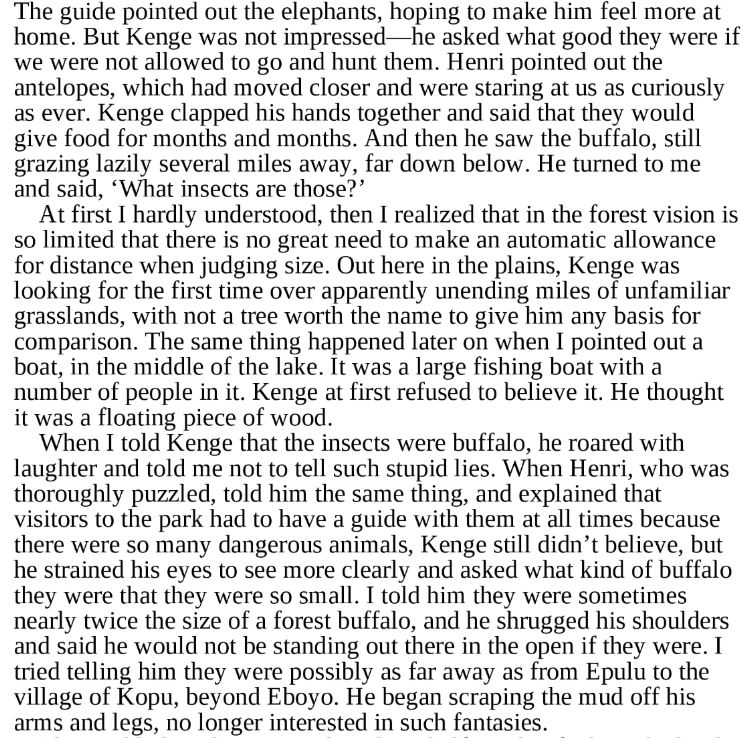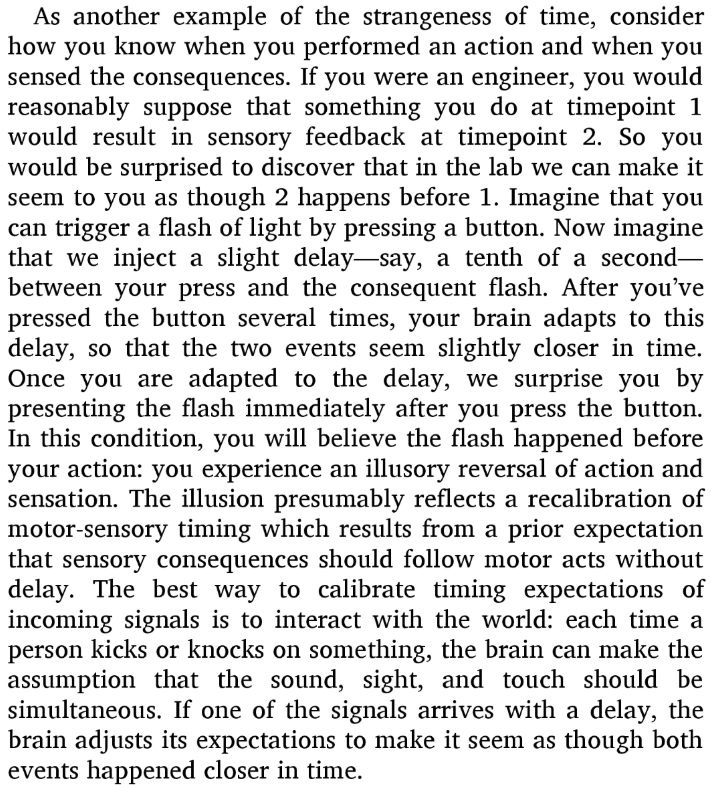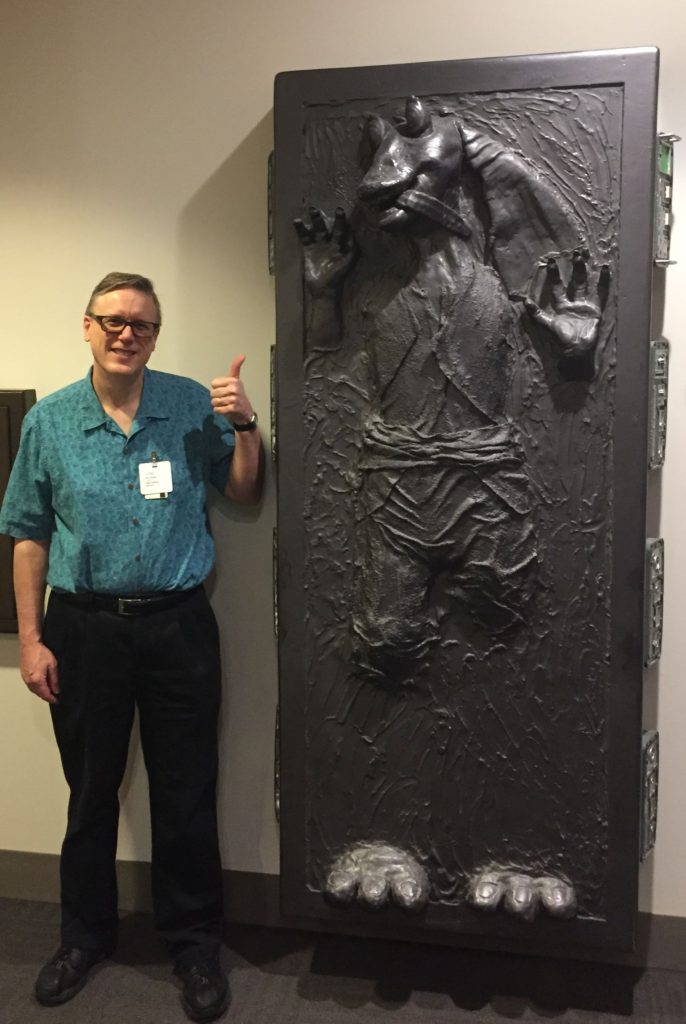Like the title says, and get it here. A few important errata for Chapter 3 were reported by a reader, Ebor Folkertsma, and so have been fixed by Tomas in this newest PDF, as well as fixing the caption for Listing 27-2. Let us know of any bugs you find so we can fix them: erich@acm.org
Monthly Archives: October 2019
Two Tales of Perception
I just finished The Case Against Reality – didn’t love it. But it did have some tidbits about perception that were intriguing, such as the split-brain patient who was atheist on one side of the brain; the other, religious.
Reading it reminded me of stories about perception in two other books, which I want to pass on here. The first is from The Forest People, a lovely older book in which an anthropologist studies the Mbuti pygmy people, living with them for three years. Here he travels to grasslands with a friend from the tribe, who had never been outside the jungle before.

How are our own perceptions affected by our upbringing? How does more use of screen and virtual reality affect us? Perhaps it makes graphics easier, in some sense? I recall when physically based shading models started to replace Blinn-Phong, people complained that things didn’t look right with the new models, even though they were more realistic.
Next is a little experiment described in Incognito, which is the best bathroom book ever – there’s something new every few pages.

This makes me wonder a bit about lag & latency and how they’re best measured, or can be mitigated.
Anyway, both books are wonderful, and I had to resist adding the stories about the sacred drainpipe and about chicken sexing.
I3D 2020 Call For Papers
The I3D Call For Papers is up: http://i3dsymposium.github.io/2020/cfp.html
Key dates:
13 December 2019 Paper submission deadline
20 December 2019 Extension for re-submissions (see details above)
10 February 2020 Notification of committee decisions
24 February 2020 Camera-ready deadline for accepted papers
9 March 2020 Poster submission deadline
5-7 May 2020 Conference at ILM in the Presidio, San Francisco
LinkedIn Invites
I’m posting because I gave a lecture on ray & path tracing last Monday, and at the end gave a little career advice, at the request of the people running the class. One thing I ranted about was getting LinkedIn invites without any explanation. I did say to the audience, students, that they could ask me for a connection, if they wanted. I guess I didn’t make it clear that they, too, should add an explanatory note – “loved your lecture, you’re the best person on the planet” or whatever – as I then received two invites without any notes that I tracked down as being students at the lecture (and so accepted). Next time I’ll be clearer…
I get a lot of LinkedIn invites – I suspect most people do. My rule is I accept if (a) I clearly know you or (b) you work for the same company as I do or have some other obvious direct connection or (c) you added a little note as to why we should connect.
I see varying advice on this. LinkedIn itself blogs on the topic, saying not to connect to random people. But most of the people who want to connect are semi-random – they usually are interested in computer graphics. Some site with an icky (to me) URL of linkedinriches.com (with “$” for that final “s” on the website itself) says I should accept everything except the utter randos, which does have a logic to it – who really cares who connects? But, if I get a note from the inviter, I’ll go with the assumption that I know them somehow. And if I see I have a connection with someone, I’ll assume I can contact them, as we somehow know each other – I don’t want to be the rando if I DM them.
My own feeling is that if someone doesn’t know me and doesn’t spend half a minute to write me a sentence for why we should connect (I always do, when connecting with someone else I don’t know), then I’ll ignore the request. As LinkedIn says, such requests are indistinguishable, disingenuous, lacking creativity, or lazy. Am I missing something here?
Reply on Twitter, if you’re interested (sadly, spammers have led to us mostly turning off comments on this blog itself).
And if you did make a no-explanation invite and would like to explain why we truly should connect, great: email me, erich@acm.org (once upon a time I would not post my email address, but Gmail’s spam filter is quite effective). I currently see 35 pending invites, and you all look to be fine people (except you, Fred), so let me know why you want to connect.
I3D 2020 Location and Dates
Date: conference is May 5-7th 2020 (the venue was already booked for May 4th – I’ll let you puzzle out why). Call For Papers coming soon – due date likely in December (judging from past conferences).
Location: Industrial Light and Magic at the Presidio, San Francisco. Naty Hoffman did a lot of work to make this happen, and I’m super-excited that it will be there – pleasant buildings in a lovely location with cool memorabilia in a great city. And that last link is definitely worth clicking – Google Earth’s fun.
This is the I3D you don’t want to miss (especially once you submit your best work!).
